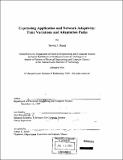Expressing application and network adaptivity : time variations and adaptation paths
Author(s)
Bauer, Steven J. (Steven Joseph), 1976-
DownloadFull printable version (3.408Mb)
Other Contributors
Massachusetts Institute of Technology. Dept. of Electrical Engineering and Computer Science.
Advisor
John Wroclawski.
Terms of use
Metadata
Show full item recordAbstract
Existing wireless networks provide a wide variety of service capabilities. Due to the inherent nature of wireless transmissions, these services are often characterized by high error rates, variable bandwidths and delays, and unpredictable interruptions. Users and applications are somewhat adaptive in their ability to handle these variable service conditions. However applications are not completely flexible nor does the user perceived quality vary in uniform fashion with the changes in network service. By characterizing flexibility, network service variations and application behaviors can be correlated to improve the QoS provided. To this end, this thesis argues that two new concepts, adaptation paths and time constraints, are important. Adaptation paths specify the ways in which network services and traffic can or do change with time. Time constraints capture aspects of QoS requirements related to time. In particular, two time constraints are introduced. First, a Discernible Service Time (DST) captures the duration for which a level of service must or will be provided before it is changed. Second, Interrupt Time (IT) captures durations for which a particular service may be interrupted for whatever reason. To demonstrate the utility of theses constructs this thesis provides a number of examples for how these extensions can be employed in wireless networks to improve QoS.
Description
Thesis (S.M.)--Massachusetts Institute of Technology, Dept. of Electrical Engineering and Computer Science, February 2001. Includes bibliographical references (leaves 45-48).
Date issued
2001Department
Massachusetts Institute of Technology. Department of Electrical Engineering and Computer SciencePublisher
Massachusetts Institute of Technology
Keywords
Electrical Engineering and Computer Science.
